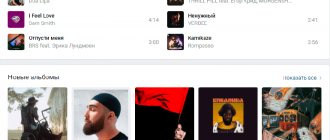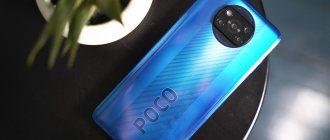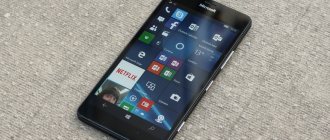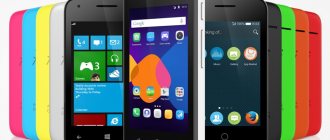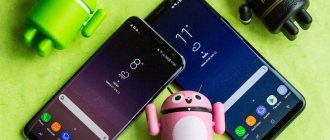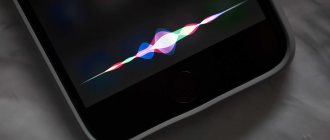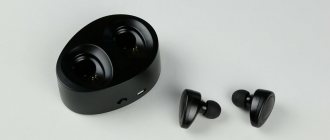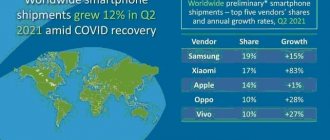Author: Lentochka
15 February 2022 10:26
Tags: stories reviews smartphones phones photos
34689
21
Just 13-15 years ago they drove us crazy, but today we remember them with warm nostalgia. 15 legendary mobile phones - which one did you have?
We have almost forgotten how to call pocket dialers the words “telephone” or “cell phone” - everything has been replaced by the ubiquitous smartphones, as if there were no phones in the world before “shovels” with a touch screen. But they existed and were beautiful! Ferra remembered the most important and widespread mobile phones since the times of “dollar” tariffs for your iPhones.
Nokia 3310 (2000)
0
Source:
See all photos in the gallery
One of the most famous and popular mobile phones in the world, and not due to the processor, megapixels, screen resolution or body thickness. In 2000, no one was interested in such matters, and even before the advent of “send SMS to order a ringtone” there were several years left. To be fair, already at that time there were much cooler mobile phones from a functional point of view. And the Nokia 3310 didn’t even have any shock/water resistance certificates. And there was no need - the phone turned out to be so durable that it “sold itself”! Moreover, it was inexpensive, so Nokia sold over a hundred million of these handsets, and the reliability of this model is still legendary (and has crash tests). The primitive game “Snake”, poisonous green lighting and a set of monophonic ringtones were enough for happiness. And the reserve quality factor and “thick” technical process of components are for trouble-free operation for years on end. Remember this when the display segment of your smartphone “floats” or “burns out” or the internal storage wears out.
×
0
Source:
Nokia 3210/3310
announcements and advertising
RTX 3070 Ti Aorus at a non-Ti price
RTX 3080 for 288 tr in Citylink
RTX 3090 MSI for 539 TR
Earn money by participating in the content of our site
Another 3080 is even cheaper - see the price
Cool 3060 Ti Gigabyte Aorus fell in price 2 times
It seems to me that many people remember this workhorse. Nokia 3210 and 3310 are the first phone models of those years with an antenna inside the body. They also had a game that many people remember even now - Snake.
Siemens ME45 (2001)
0
Source:
Compact, super-durable, waterproof, fast, desperately loved by the people, a mobile phone nicknamed “Messer”. Sophisticated, like all Siemens, and noticeably cheaper in comparison with flagship models. And most importantly, it is the first secure smartphone of its kind without flashy “offal” and design to suit the tastes of students. A serious model for serious people, which, however, did not stop fans from upgrading (at that time not without the help of a programmer) the Messer with firmware from the more prestigious Siemens S45. A huge notebook, a voice recorder with a recording duration of up to three minutes (why are you laughing? It’s been worse), GPRS support and an infrared port for modem-computer needs. A universal tool for lovers of sophisticated yet durable phones. And don't forget about one of the first MP3 player phones with memory card support - Siemens SL45!
Iconic mobile phones, 8th place – Ericsson R520
Those who have owned this device in the past might have been a little upset, because the eighth participant in the ranking of cult phones of past years, Ericsson R520, did not have an outstanding appearance. Then there were products from other brands with more attractive outer shells, but could they imagine that this device would become legendary?
It was the first phone to have Bluetooth, as well as GPRS and email. In addition, it had an infrared port, an address book for 500 contacts, and a WAP browser for downloading monophonic melodies. At that time, the device was used not only for calls and SMS, but also to emphasize its status, because in 2002 it cost a lot of money.
Sony Ericsson T68i (2002)
0
Source:
Today, almost no one will remember that Sony mobile phones were designed jointly with “something” Ericsson. But it was thanks to a joint concern with the Swedes that the famous one became popular in the mobile market. The T68i was one of the reasons for this success. Why? Well, for example, because it was one of the first mobile phones on Earth with a color screen and “full stuffing” as of 2002. The presence of Bluetooth, an infrared port, MMS support, the ability to create your own, albeit monophonic, melodies. A compact body and a joystick, innovative for those times, instead of arrow keys (later Sony Ericsson users will curse this joystick, but that’s for later). In general, the Japanese-Swedes won the love of the people with a very successful, intelligent, no matter how you look at it, flagship of the 2002 model year.
Worth mentioning
Ericsson T28s
This little guy with an antenna and a slamming flip really stood out against the backdrop of the “bulky” and “fat guys” of the end of the last century. It was new to users that the phone practically did not weigh down the pocket.
Apple iPhone
The first iPhone made a lot of noise back in 2007. Even if it did not have 3G, MMS, Bluetooth and some other things familiar at that time, all this turned out to be not so significant, because a large, high-quality touch screen, the beauty and simplicity of the software shell led to a real revolution and the emergence of a completely new concept of mobile devices.
LG KG800 Chocolate
In addition to decent functionality, this phone attracted attention with its appearance. The black glossy surface with red control buttons that light up when the slider opens made this phone one of the most elegant on the market. By the way, the buttons were not simple, but touch-sensitive.
Samsung C100 (2003)
0
Source:
Back in 2003, Samsung was in the mobile market something akin to the current HTC - that is, it would be hard to say that the company does not know how to produce high-quality phones, but obviously not all of them “shoot” and not always. But Samsung made a model that “shot” - an ultra-thin (now you’ll laugh - 17 mm), pretentious, cool and relatively affordable handset with the C100 index turned Samsung from an “upstart” into an image. Because yes - the display based on the UFB matrix was brighter and cooler than the CSTN and TFT TN of competitors, and the 40-voice polyphony sang simply at the “super-lux” level in comparison with the dull tunes in Nokia or Siemens. And the C100 was absolutely “glitch-free” and stable, which was rare in models with a sophisticated multimedia component of that time.
Motorola MPx200 (2003)
0
Yes, yes, yes, Motorola released funny budget “tadpoles” and a successful C-series with a color display at a ridiculous price, but will this really impress anyone in the era of auto-updating applications and custom firmware? But among the oldest smartphone professions, the MPx200 and its restyling, the MPx220, were cool and will remain so forever. Folding smartphones are completely extinct today, but they weren’t widespread in ancient times either. And before that, no one had ever “collectively farmed” non-touch devices based on the Windows Mobile 2002 system (you remember the typical appearance of communicators, right?). But Motorola tried - and succeeded! At first, the smartphone was very expensive and no one stood in line for it, but if we are talking about Russia, then Russian cell phone stores eventually gave up and “dropped” the price of the sophisticated Motorola to the average level (5,000 rubles - the equivalent of today’s thirty thousand or a little less) - and enthusiasts snapped up the MPx200, and let’s install applications on them, enjoy multitasking (a luxury in the old days), watching videos and cool browsers!
0
Samsung X100 (2003)
View on AliExpress
A truly iconic model that revolutionized the world of monochrome phones - it was the first phone with color animation, and in addition it had:
- bright multicolor screen;
- many interesting applications;
- 37 installed melodies;
- ability to download 3 tracks;
- telephone book for 500 subscribers.
It is worth adding to this the ability to work on a single charge for up to 4 days, which made the phone a bestseller - every third person carried it.
Interesting fact!
The game BubbleSmile from this model became the prototype of many modern logic arcade games.
Siemens SX1 (2003)
0
Source:
Understand correctly - we are not even trying to challenge the primacy and greatness of Nokia in the production of Symbian smartphones, but there were tons of models with four-digit indices, and it is not clear why the “cutlet” Nokia 6600 should be noted, and the pioneer, 7650, budget 3650 or gaming N -Gage, no. Nokia has had “2000” and brighter models, but there is only one such “SYCH” - the first and last Symbian smartphone from Siemens. I must say, the Germans managed to leave a mark on history - the keys in place of the side edges even today look “cosmic”, but 14 years ago they were simply amazing. Compared to the “barrel”, the SX1 could boast of better sound quality (Nokia was not shy about releasing Symbian smartphones with mono sound in headphones), a more vigorous processor and an advanced camera application. However, like any Siemens, it was a little buggy, and it was released to the public with the already outdated Symbian 6.1 platform - very soon this factor led to some shortage of software supported by the smartphone. But the SX1 played its role - a bright, fast, youth smartphone open to experimentation; there haven’t been many of these in the history of the “corporately strict” Symbian.
0
Sony Ericsson K500i (2004)
0
Source:
But it was not at all necessary to be a smartphone in order to be loved by enthusiasts - in the era of wildly expensive “smart mobile phones”, simpler models became truly popular. For example, the low-cost version of the flagship SE K700. Yes, the display resolution of the “five hundredth tractor” was cut from 176x220 to 128x160 pixels, and the memory capacity was only 12 MB. But at that time, the characteristics were no less good than in your Redmi 4 or Honor 5A at the beginning of 2022. That is, you can live, and live well! Because: a camera that is “adult” in quality and capabilities, support for all conceivable audio formats, a fast and stable IR port, a very cool and productive Java machine that could work in the background (very useful for keeping ICQ there) and save data to internal memory (useful for games and Opera Mini). An excellent model for everyday use, the durability of which was spoiled only by the damned joystick (okay, I won’t think about it anymore).
Apple iPhone (2007)
The phone was released at the beginning of 2007, and now for us it symbolizes the beginning of a new era in the world of mobile technology. The ability to control an interface with multiple fingers simultaneously, without the need for a stylus, is now a standard in smartphones.
The first iPhone was expensive - with a two-year contract with one of the operators, you had to pay $599 for the best version. The trend of queuing in front of stores began then and will likely continue for a long time.
Interesting fact!
Microsoft's Steve Ballmer and virtually every executive at Research In Motion (now BlackBerry) at the time didn't believe a phone without a physical keyboard would succeed. Time has shown that Steve Jobs was right.
Siemens M65 (2004)
0
Source:
You know what? I, too, was and still am rooting for the “phablet” of that time - the Siemens CX65, but since we are limited in the number of smartphones for today’s article, it is worth mentioning the “tank” under the symbol M65. A case with a metal frame, resistant to shock, water and dust, a huge and bright display by the standards of 2004, a loud speaker, an infrared port with no restrictions on the type of transferred files (otherwise those Nokias and Samsungs of yours have had some scams...), the ability tuning the firmware with “elves” - executable files like the “bucketoid” Xposed, only better... Yes, a lot of things could be done with this phone in software terms. Apart from normal support for MP3 files, perhaps. In general, the “em-sixty-five” was both cool in the multimedia component and in the issue of protecting the body from external influences. Even today, when flagships are increasingly equipped with water resistance, and, in exceptional cases, shockproof components, this combination of bells and whistles and protection remains remarkable.
Siemens C65 (2004)
Photo source: Freeim
A mass-produced device that, despite the price, was quite functional for its time. His phone book contained up to 1000 contacts with 22 fields each. At the same time, if the dates of birth of subscribers were entered, reminders about them were activated automatically. The organizer and voice recorder were limited by the amount of free memory - there was a total of 10.5 MB. Considering the fact that even the most demanding games then weighed about 200 KB, this was enough. By the way, there was support for Java applications. 40-voice polyphony no longer surprised anyone, but it was possible to download audio files in WAV format. When played, such melodies are practically no different from MP3, but they take up more space. The camera could not boast of image quality, but such phones were not bought for photography.
Motorola E398 (2004)
0
Source:
Motorola in the early 2000s irritated customers with its always sluggish menus and not very stable firmware, and the quality of shooting on the first cameras in mobile phones did not shine. But Moto had “tricks” that the vaunted Nokia, Siemens and Sony Ericsson were unable to offer either before or after the release of the iconic “big M” models. One of these was the Motorola E398 - “a boombox in your pocket.” A phone with powerful stereo speakers that shook the body at maximum volume, an affordable price and support for new microSD memory cards. Then, based on the E398, Apple even decided to create a “under-iPhone” - ROKR E1 with support for Apple iTunes, but that’s a separate, sad story.
Pantech PG6200
So we have reached the so-called “elite” of phones of the early 2000s.
Pantech released an attractive and no less interesting device in 2006, which (even then!) had a fingerprint scanner. Phone showing your image - Pantech PG6200
The phone had a strict design and was aimed more at business-style people who respect the protection of data that is present in the phone. The PG6200 also had a 2 MP camera, an MP3 player, Bluetooth and a slot for a memory card.
Motorola RAZR V3 (2004)
0
Well, in order not to get up twice, the most obvious phone in this article is the “razor”. The standard of mobile phone design, the most stylish “flip phone” of all time, the “sex symbol” of the mobile industry - whatever you want to call it, but this metal phone excited, excites and will excite (they are still rowing from Aliexpress) the minds of everyone who loves unusual and stylish “dialers”. Even Motorola itself did not expect the RAZR to be such a hit - the developers were no strangers to creating spectacular models with an unusual appearance. But in the case of V3, the creators managed to pack all the goodies of modern models (two color displays, support for modern features, from MMS to MP3 and GPRS) into a price that is acceptable to most buyers. No, the RAZR was not cheap, but it also did not cost at the level of flagships floating in the clouds. Despite the lack of memory (10 MB), slowness, poor autonomy, and short key travel, the mobile phone became a hit - so much so that from the day the V3 was released, Motorola continued to release “restylings” of the sensational smartphone and produce all-in-one SLVR phones, using the same design, until “suddenly” the era of smartphones buried the entire company almost on the vine. What happened next to Moto is a well-known story.
0
Best Motorola phones
Motorola Inc has existed since 1928 and at one time occupied a leading position in the field of telecommunications. But since 2011, it ceased to exist as such and was divided into several independent companies. However, in the twilight of its existence, Motorola pleased us with several interesting mobile phones.
Motorola C115
This small phone has become popular largely due to its low cost and practicality . The C115 model had a simple and elegant appearance, but it could not be called banal - it was distinguished from the “crowd” by its tadpole-like profile. The phone was thicker near the screen and narrowed at the keyboard level - this is convenient and original.
The functionality of the C115 is minimal: the ability to make calls, an alarm clock, a calculator, and other little things. In addition, there was a game called “Football” on the appetizer, which allowed you to kill time.
The device was available in three colors: black, silver and transparent . The latter represented an unusual solution, when the insides of the phone were visible through the body, illuminated by the backlight.
Silver and “transparent” version
By the way, the Motorola C115 was highly valued for its good battery capacity of 920 mAh , which, coupled with low power consumption, allowed it to work for up to 5 days without recharging.
Motorola E398
This product came out at about the same time as the C115, but was no longer part of the budget line, although it was much cheaper than competitors with similar functionality.
The main feature of the E398 was its powerful stereo speakers , for which the device was deservedly called a “tape recorder in your pocket.” The speakers were not only very loud, but also provided high quality music reproduction. The speaker grilles had built-in indicator lights that changed colors depending on the set color scheme.
Side view
The light and music mode also aroused interest . It worked like this: the sensitivity of the microphone was adjusted, the operating time of the function was set, and the color scheme was selected. After which the phone began to shimmer to the beat of the music being played. At that time it was a curiosity.
What is the light-music mode on Motorola E398:
The characteristics of the Motorola E398 were in line with the trends: TFT display with 176x220 pixels, 64 MB of memory, support for TriFlash cards, Java games, Bluetooth, etc. and so on.
Motorola RAZR V3
This stylish flip phone has been called by some to be Motorola's best creation yet. This was largely due to the progressive design of the phone : an ultra-thin profile, a keyboard in the form of a metal plate and electroluminescent backlight. Actually, due to its small thickness and abundance of metal elements, the model was named RAZR (from the English “razor” - razor).
It is believed that it was the RAZR V3 that set the fashion for thin mobile phones. The concept of the keyboard at that time was also unique - the keys and symbols on them were literally carved onto a metal plate.
Motorola RAZR V3 in different colors
The device is equipped with an external screen , which displays all the necessary information, a picture from the camera and a photo of the caller. Otherwise, everything you need is there: Java support, Bluetooth, an average VGA camera and MP3.
Motorola RAZR V3 review:
Interestingly, most of the official pictures of Motorola phones show the time as 11:35 AM. That's exactly what was on the clock when, on April 3, 1973, Motorola employee Martin Cooper made the world's first call from a mobile phone.
Nokia N70 (2005)
0
Source:
*scrolling through the list of all Symbian smartphones*. Oh, God bless them - I suggest we kindly remember the Nokia N70 - the model that personifies the luxury and prosperity of Symbian smartphones. When archaic models based on Symbian 6.x were finally a thing of the past, and the rollicking guard of models based on the new S60 3rd (do you remember how fun it was to hack certificates on your old Symbianphones?) had not yet appeared, the N70 was the ideal “burgher” » smartphone. Finally, with “tons” of RAM (an old problem with Symbian), good sound, a powerful processor, a high-quality camera, and virtually no flaws. Then, when Nokia began to produce Symbian models in huge quantities, the “calculator” design E71, and the super-camera smartphone N90, and the “mobile computer” Nokia N95 (and a guard of its fakes) were born, but, perhaps, it was precisely from N70 Symbian smartphones acquired truly modern hardware and since then they have simply built up their “muscles” to excess and improved the quality of displays and cameras.
Nokia N90
“The coolest phone for photos” - this is exactly what Nokia wanted when they released this phone. Not just a “shell”, but a “shell in which the screen turns.” This was a very extravagant solution from Nokia, but this is what won the hearts of all consumers.
A 2 megapixel camera, autofocus, built-in flash, 20x zoom - this phone was worthy of being called a “camera phone.”
As for functionality, it surpassed many of the RAZR V3. Nokia N90 ran on Symbian OS, thanks to which it moved from the “phones” league to a new league – “smartphones”. Only the weight of 173 grams was some disadvantage of this model.
Sony Ericsson M600i (2006)
0
Source:
Yes, yes, I decided to remember the “communicators with a human face” - touchscreen Symbian UIQ, which Sony Ericsson personally developed. From an academic point of view, we should start with 2002 and the release of the SE P800, but if we are to be realistic, then from its very inception the P-series was outrageously expensive, applications from the Symbian S60 could not be installed on less popular “sonicers”, and business the audience has long and extensively used Windows communicators, which I don’t want to talk about in detail in this article - we’ll drown in their number and characteristic features. So, the M600 became the first more or less “folk” communicator running Symbian UIQ. Without a folding cover with a keyboard, but with “dual-purpose” keys when entering text, with a smartphone appearance and a proprietary JogDial wheel (oh-oh, this is an old story that dates back to the days of “purebred” Sony mobile phones). This model was chosen by those who were damn tired of Nokia smartphones and didn’t like the rare Samsung smartphones - the Koreans then grabbed onto everything and released good models, but they were all “bland”, “without a soul”, and therefore were almost not popular.
0
Source:
True, the M600 was buggy, the popularity of the already niche system was on the wane, and this model also did not have a rear camera - a tradition, you know, of corporate-oriented phones. As a result, the star of the Symbian alternative faded before the iPhone and its many “killers” were born. It's a pity.
Nokia 8800 (2005)
0
Source:
The “600th Mercedes” among mobile phones, the main anti-smartphone and living proof that the same model can evoke sympathy among enthusiasts and people who are not tech-savvy. Of course, before the 8800, Nokia had many other fashion models (for example, the old 8910), but only this model became a household name, a brand in itself, so to speak. In 2005, the symbol of quality was a steel case (not these pans that are in your Chinese phones, but a qualitatively different case), an automatic closer for opening the case, and the now familiar “scratch-resistant” glass on top of the display. The hardware is half good, half ridiculous. Only 64 megabytes (megabytes!!!) of built-in memory and a 0.3-megapixel camera, already dreary in those days, but super-beautiful ringtones (they were created to order in collaboration with the famous Japanese composer) and a high-quality display worthy for such a diagonal resolution 208x208 pixels. And the Nokia 8800 is a joke phone, because it was at the time of its debut that there was a boom in the production of counterfeit mobile phones. A huge number of entrepreneurs at the level of “brother, they gave me a top-end Finnish phone for debts, do you want me to sell it to you at a discount?” successfully deceived our compatriots, and sometimes semi-working rubbish under the guise of 8800 was deliberately bought by those who liked to show off. One way or another, the prestige of the “Nokia-almost-vert” has not faded even 12 years after its debut, and this, you know, says a lot.
The evolution of smartphones. Part 1: 1994 - 2010
Back in 2013, I published an article Old advertisements for cell phones and smartphones (from the 1980s to the end of the 2000s), where you can watch the brightest phones from the 1980s. But this time I want to track specifically smartphones - communicators, smart phones, phablets, lampshades and other devices of the same type, the mere definition of the name of which caused battles among geeks. And so you need to start with IBM Simon, released more than 20 years ago. Then we will move on to Symbian devices, the appearance of the first iPhone and the first Android smartphone from HTC, remember devices from Nokia and end the journey with the latest gadgets introduced in 2016.
In the comments, please share your memories and provide links to your own reviews.
If the article is missing a specific model, please write about it in the comments with an image. This way we will make “Evolution” more complete.
IBM Simon
The IBM Simon had a large 4.7-inch monochrome display with a resolution of 160x293 pixels, and weighed half a kilo excluding the docking station. This futuristic for that time mixture of a computer and a telephone without a keyboard, but with a touch screen, combined a mobile phone, a pager, an organizer, mail, and an alarm clock. The gadget ran on a 16-bit Vadem VG-230 16 MHz processor. By the way, there was a whole megabyte of RAM. Want to see what's inside? Read the analysis on Habré, and in the post on Geektimes read how you can upload pictures to this gadget.
Film "Network", 1995.
Nokia 9000 Communicator
Was it possible not to dream about this device from Nokia in 1996?
It had a keyboard and two monochrome displays - an internal 4.5-inch 640x200 pixels, an external one 50x38. The gadget weighed 397 grams - you could fight off anyone. For the first time the device was called “Communicator”.
Ericsson R380
Let's move on to the first device, which was called a “smart phone” as part of the manufacturer’s advertising campaign.
This is the Ericsson R380, another gadget with a large 3.7-inch touch screen and the Symbian operating system. Before this, Ericsson made a lot of handheld computers without the ability to make calls and phones without the ability to use them as computers. “We call it a smartphone,” the ad says. The device was introduced to the world in December 1999, and began selling in 2000.
BlackBerry 5810
The history of Blackberry began in 1984, when University of Waterloo student Mike Lazaridis registered RIM - Research In Motion. The company began by designing devices for wireless data transmission, and in the 1990s borrowed text-transfer technologies over paging networks from Ericsson and RAM Mobile Data, after which it released a pager with a QWERTY keyboard that allows you to send messages. Further, most Blackberry devices looked exactly like this.
The first Blackberry smartphone appeared in 2002. The BlackBerry 5810 did not have a speaker or microphone; a headset was needed for conversations. But there was a keyboard.
Nokia 9210
Nokia 9210 continues the line of “communicators” from the Finnish company.
The gadget was released on Symbian OS 6.0 in 2002, but I still remember how much I wanted to get one. And I don’t know what I would do with it? Nokia 9210 boasted a 640x200 pixel color screen, 8 MB of RAM and 14 MB of internal memory. He didn’t work for long then - 10 hours. Review - here.
Nokia 7650
Nokia 7650, announced on June 26, 2002, was the first smartphone on Symbian OS - before that there were only communicators.
Here you can start arguing about what should be called what. The device was dubbed a “camera phone” in the media for its built-in camera, and it actually became the first device from Nokia with a camera.
Processor: 32-bit RISC 104 MHz. Memory - 4 megabytes, of which only 3.4 MB was available to the user.
Sony Ericsson P800
In 2002, Sony Ericsson introduced the P800 smartphone with a UIQ 2.0 interface based on Symbian OS v 7.0.
HTC Wallaby
Since April 2002, HTC has produced handheld personal computers running Windows Mobile.
The first was HTC Wallaby with an Intel StrongARM 206 MHz processor, 32 MB of RAM and the same amount of flash memory, support for MMC and SD cards, a 3.5-inch TFT display with a resolution of 240x320 pixels... Operating system - Microsoft Pocket PC 2002 Phone Edition. A year later, HTC Falcon appeared.
‘
And in 2004 - HTC Himalaya. This handheld no longer had a huge antenna.
Siemens SX1
In February 2003, the German company Siemens announced its entry into the smartphone market with the original Siemens SX1 on Symbian OS. The number keys are located on both sides of the case. When sales began in December 2003, the gadget cost $750, but in two years the price dropped to $250.
At the Hanover exhibition in 2005, Siemens demonstrated a new smartphone concept - with a laser keyboard.
Sony Ericsson P910
In 2004, Sony Ericsson P910 was released. The gadget received a QWERTY keyboard on the back of the flip. In this case, the flip can be removed from the gadget altogether to get a classic version of a smartphone with a minimum of buttons. The Symbian model is built on an ARM9 156 MHz processor, has 64 megabytes of RAM and supports Memory Stick PRO Duo up to 2 gigabytes.
HTC BlueAngel
HTC Blueangel went on sale in October 2004.
It was made under various brands, including Siemens. The display diagonal is 3.5 inches, memory is 96 MB built-in and 128 MB RAM. The device ran on Windows Mobile 2003SE. Processor - Intel PXA263 400 MHz. The gadget is made in a slider form factor with a full-size keyboard. Later there were Alpine, Gemini, Apache, Galaxy, Wizard, Prophet, Charmer, Hermes, Trinity and many other devices running Microsoft operating systems.
BlackBerry 7210
BlackBerry 7210 was the first Blackberry smartphone with a color display. The gadget had 2 megabytes of built-in memory and a 960 mAh battery.
HTC Magician
The Qtek S100 smartphone manufactured by HTC has been sold since 2005 under different names - 2 Xda II Mini (Asia), O2 Xda mini (Germany), T-Mobile MDA compact, i-mate JAM, Vodafone VPA Compact, Dopod 818, Krome Spy, and Orange SPV M500. This Windows Mobile 2003 device had 64 MB of built-in memory and the same amount of RAM, a slot for SDIO/MMC cards, a 1.3 megapixel camera, and a 2.8-inch screen with a resolution of 240x320 pixels.
Lenovo P930
Nokia, Psion, Ericsson and Motorola teamed up to develop Symbian OS in 1998.
Later, Sony Ericsson, Siemens, Panasonic, Fujitsu, Samsung, Sony, Sharp and Sanyo joined the consortium. The Symbian platform was the most popular smartphone platform in the world in the mid-2000s. Read about the rise and fall of Symbian here. The first Symbian gadget from Lenovo was the Lenovo P930 in 2005. The device supported GPRS, had a color display with stylus input and a 1-megapixel camera. Memory could be expanded using SD/MMC memory cards. The smartphone had a GPS navigator, an MP3 player, and it was possible to install JAVA applications on it.
Lenovo ET980
The Lenovo ET980 smartphone running Windows Mobile 5.0 received an Intel PXA270 312 MHz processor. The cover on the smartphone added regular buttons to it. The release of the gadget began in 2005.
Google buys Android
In July 2005, Google purchased Android Inc., in November 2007, it announced the creation of the Open Handset Alliance and announced the open Android mobile platform. In the same month, the alliance introduces the first version of the package for developers. In 2008, the first version of the operating system was released.
HTC P3600
In September 2006, HTC released the P3600 on Windows Mobile - a 150-gram communicator with a 2.8-inch TFT display and a resolution of 240x320, two cameras - a main 2 MP and a front one, 64 MB of RAM and 128 MB of internal memory. Samsung produced the processor for the smartphone.
Nokia N95
In March 2007, the Finns released the Nokia N95.
A Habr user called him the King of Smartphones, and in the first comment, another user expressed his “fi”: “there is no Qwerty keyboard, so I won’t even look in his direction.” Form factor: brick-slider. Display - 2.6-inch 240x320 pixels. Processor with a clock frequency of 330 MHz. Internal memory 160 MB. Camera - 5 megapixel with autofocus, electronic stabilizer and built-in flash. The gadget ran on Symbian OS v9.2.
iPhone
In May 2007, it became known that Apple iPhone sales would begin in June. Steve Jobs tried to get the most out of his subordinates so that the device was close to ideal. More than one book has been written about this.
HTC S740
The HTC S740 smartphone was released in 2008. It was built on a Qualcomm MSM7225 528 MHz processor, had 256 megabytes of RAM and built-in memory, and supported microSD. The screen diagonal is 2.4 inches and the resolution is 320x240 pixels.
BlackBerry Pearl 8120
In October 2007, BlackBerry released one of its first smartphones aimed not at the corporate segment, but at ordinary users.
The BlackBerry Pearl 8120 smartphone received a simplified keyboard - perhaps it could be called “semi-QWERTY”, a 2 megapixel camera and Wi-Fi support. The color LCD display had a resolution of 240x260 pixels. The internal memory of 64 megabytes could be increased using microSD.
BlackBerry Bold 9000
The BlackBerry Bold 9000 smartphone has a 2.6-inch display (non-touch) with a resolution of 460x320 pixels, a 2-megapixel camera and a 624 MHz processor. RAM is 128 megabytes, and the built-in memory is already a whole gigabyte. It was the first smartphone from RIM with GPS. The device was announced on May 12, 2008, and began selling on July 9, 2008.
iPhone 3G
On June 10, 2008, Apple introduced the iPhone 3G, an improved model in which the company tried to get rid of the shortcomings of the first version - for example, the device now connected to 3G networks.
HTC Dream
Sales of the HTC Dream, HTC's first Android device, began shipping in April 2009.
Photos of this “GooglePhone” and the “iPhone killer” first appeared online in September 2008. The smartphone received a qwerty keyboard, a 3-megapixel camera and a 3.5-inch touch display. A year after the release of the smartphone, Apple accused HTC of violating 20 patents and prepared more than 700 pages describing the claims:
We can sit back and watch our competitors steal our patented inventions, or we can do something about it. We decided to take action. We believe that competition in the market is healthy, but competitors should create their own unique technologies and not steal ours.
To this press release declaring war on HTC, the Taiwanese company gave a logical response:
We only became aware of Apple's intentions through a press release. The court document has not yet been served, so we cannot comment on the allegations at this time. We respect the value of patent rights, but we also want to protect our own innovations. We have been inventing and patenting our own technologies for over 13 years.
The list of devices that allegedly violated Apple's patents included Nexus One, Touch Pro, Touch Diamond, Touch Pro2, Tilt II, Pure, Imagio, Dream / G1, myTouch 3G, Hero, HD2 and Droid Eris. And this can be called recognition from Apple.
Samsung Galaxy
The Korean company Samsung announced the first smartphone in the Galaxy line on April 27, 2009, a few days after the start of sales of the HTC Dream.
A tiny 3.2-inch AMOLED screen, a 5-megapixel camera with autofocus and LED flash, a 3.5 mm headphone jack, a set of pre-installed applications from Google, 8 GB of internal memory, a 1500 mAh battery - this is what the Samsung Galaxy could boast of i7500. Read the review here. Russian commercial - filmed in one take.
HTC Magic
HTC's second Android phone, the HTC Magic, was released in April 2009 and demonstrated in February of the same year at Mobile World Congress. Read the smartphone review here. Notice the insert around the camera.
BlackBerry Storm 9500
In 2008, BlackBerry released its first smartphone with a touchscreen and no QWERTY keyboard. The gadget was presented in September and released in November 2008. The device received a 3.25-inch display with a resolution of 360x480 pixels. Processor - Qualcomm MSM7600 528 MHz. Again, the gadget had 128 megabytes of RAM. Built-in - 1 gigabyte, and there was support for microSD up to 16 GB.
Nokia 5800 XpressMusic
The Nokia 5800 smartphone was introduced in October 2008.
The device had a 3.2-inch screen with a resolution of 640x360 pixels. Freescale MXC300-30 ARM11 434 MHz processor, 128 megabytes of RAM. The gadget came with an 8 GB microSD. The main camera of 3.2 megapixels received Carl Zeiss optics, autofocus and LED flash.
iPhone 3GS
On June 8, 2009, at WWDC in San Francisco, Apple showed the iPhone 3GS with the updated iPhone OS 3.0. The 3.5-inch LCD display with a resolution of 320x480 pixels was developed by Apple and produced by LG. The processor is developed and produced by the Korean competitor Samsung S5PC100 ARM 833 MHz, but the hardware frequency is reduced to 600 MHz. Camera - 3 megapixels. RAM - 256 MB, built-in - 16 or 32 GB. The device received support for HSDPA communication.
HTC Hero
HTC Hero went on sale in July 2009, in Russia - in September.
This was the third HTC smartphone on the Android operating system. And the first Android smartphone to support Adobe Flash. The review is on Geektimes - read the link.
What about the technical characteristics - the Hero had 256 megabytes of flash memory and 288 megabytes of RAM. Processor - Qualcomm MSM7600A ARM11 528 MHz or MSM7200A ARM11 528 MHz.
HTC Evo 4G
The HTC Evo 4G smartphone became the first Android device to support WiMAX.
The device, powered by a 1 GHz Qualcomm QSD8650 processor, has 576 megabytes of RAM and 1 gigabyte of internal memory, a 4.3-inch screen with a resolution of 480x800 pixels and an 8-megapixel camera.
Motorola Droid
In October 2009, Motorola released the Droid smartphone, an Android slider with a QWERTY keyboard.
The device worked with Wi-Fi networks, had a 3.7-inch display with a resolution of 854x480, and supported microSD memory cards up to 16 gigabytes. Processor - Texas Instruments OMAP 3430. Built-in memory - 512 megabytes, RAM - 256 megabytes. This is the first smartphone to come with the free Google Maps Navigation app.
As of July 2010, the Motorola Droid was the most popular Android device. And second, third, fourth, fifth, eighth and ninth places in this ranking were occupied by devices from HTC.
HTC HD2
In November 2009, HTC released Leo (HD2).
This is a smartphone running the Windows Mobile operating system, with a 5-megapixel camera with autofocus, a 4.3-inch diagonal TFT display with a resolution of 480x800 pixels. Qualcomm Snapdragon QSD8250 1 GHz processor, 512 megabytes of internal memory and 488 megabytes of RAM. HTC Leo is the first smartphone with a capacitive screen running on Microsoft's operating system. It’s surprising that in a review of the smartphone on Geektimes, the following phrases popped up: “It fits like a glove in the hand, but people with small palms are unlikely to find the phone comfortable to use with one hand” and “However, it is more designed for men with large palms and fingers.” Let me remind you that the display is 4.3 inches. Now several girls I know are wearing Asus 5.5 inches and are very happy with its size.
Other reviews said, "The HD2 is truly huge." I look at my Lenovo Phab Plus and am surprised.
Nokia N900
In November 2009, Nokia released the Nokia N900 “Internet tablet”, announced on September 2 at Nokia World. The slider with a QWERTY keyboard on Maemo received 256 MB of RAM and 32 GB of flash memory, a slot for microSD up to 32 GB, a 5-megapixel camera, and a 3.5-inch screen with a resolution of 800x480 pixels.
Lenovo LePhone
On January 7, 2010, Lenovo introduced an Android smartphone - LePhone. The device has a 3.7-inch display with a resolution of 800x480, a 1 GHz Snapdragon processor, and 8 GB of internal memory. You can connect an external QWERTY keyboard, speakers and battery to the gadget. The device is initially aimed at the Chinese market.
HTC Legend
On March 1, 2010, HTC began selling the HTC Legend starting at $750.
The device boasted a 3.2-inch AMOLED display, the Android 2.2 operating system, a Qualcomm 7227 600 MHz processor, as many as 384 megabytes of RAM and 512 MB of internal memory. But the memory could be expanded via microSD up to 32 GB. Read the review, remember how it was. Although the Legend’s body was made of a single piece of aluminum, this did not affect the quality of signal reception, unlike the iPhone 4, whose signal level dropped significantly as soon as it was picked up.
The back panel is decorated with plastic inserts.
Samsung Galaxy S
Samsung Galaxy S was released in June 2010, and in just two months, 800 thousand devices were sold - an absolute record at that time for Android smartphones. The device received a 4-inch AMOLED screen with 480x800 pixels, an ARM Cortex A8 1 GHz processor, 512 MB of RAM and from 2 to 16 GB of internal memory with support for memory cards up to 32 GB. This is one of the first smartphones to support Bluetooth 3.0. The thickness of the device is 9.9 mm, it was one of the thinnest smartphones in its class. Cameras: 5 MP main and 0.3 MP front.
iPhone 4
On June 7, 2010, Apple released the new iPhone 4 with an industrial design.
Read the review full of love and adoration here. The case is made of two pieces of polished reinforced glass and a stainless steel frame, which caused problems with signal reception - and these were predicted before the device went on sale. Apple's official response:
If you hold any mobile phone in your hand, it will affect the performance of its antenna. Moreover, depending on the location of the antennas, in some places of the body this will be noticeably stronger. This is a fact of life for any cordless phone. If you've ever experienced this on your iPhone 4, avoid gripping the bottom left edge of it so that your hand touches both sides of the metal edge. Or simply use one of the many cases.
IDC Forecast
On September 7, 2010, IDC published a report forecasting growth in smartphone sales in 2010 by 55% compared to 2009. And says that by 2014 Android will occupy 24.6% of the smartphone market, Symbian - 32.9%, Blackberry - 17.3%, and iOS - 10.9%. Windows Mobile will have 9.6%.
If we look back briefly to 2014, we will see how much IDC analysts were wrong in 2010. Android took 84.8% of the market, iOS - 11.6%, Windows Phone - 2.5%. And Blackberry got only 0.5%.
Sony Ericsson K790i (2006)
0
Source:
Criticizing Sony for their waywardness years later is a safe bet. But it was the stubbornness of the Japanese company that contributed to the release of mobile phones in which all functions were brought to the absolute level. From the clumsy, but functionally interesting K700, the company moved on to the super hit K750i and its Walkman-elephant W800i, and then, while Motorola was reveling in the design of its RAZR, and Nokia was churning out “insipid” Symbian smartphones, Sony Ericsson released a “monument” to fast and high-quality “just mobile phones”. And at the same time, the photographic flagship of its time. Sony took the Cybershot brand, which is familiar from proprietary point-and-shoot cameras, out of their pocket, made the rear panel of the mobile phone similar to the one in cameras, did not skimp on a high-quality sensor and improved the performance of the operating system and Java applications (yes, J2ME was already gradually “dying” , and yet) to the highest level. Let's add to this the traditionally high-quality sound in Sony phones, and we get an almost ideal device for those who only needed a quick messenger in the background and a mobile phone not overloaded with a sophisticated operating system for everyday use. Of course, love at first sight always helps with a second glance, and if the K790i had fallen into our hands today, it would hardly have impressed us as it did at the time of its debut, but the very idea of a high-quality, fast, comprehensively developed non-smartphone has long sunk into oblivion . And you all know who is to blame for this...
Sony Ericsson K300, K500, K700
Now, I’m sure that someone reading this collection owned this incredibly popular phone. The K300 was a budget version, so it has a smaller screen and internal memory.
All of these phone models had a camera that could record video, a music player, ringtones (in MP3 format), and they even supported 3D graphics. The K700, in turn, was one of the first to use the “Setup Wizard,” which helped set up the device after purchase. And of course there was a radio in it.
